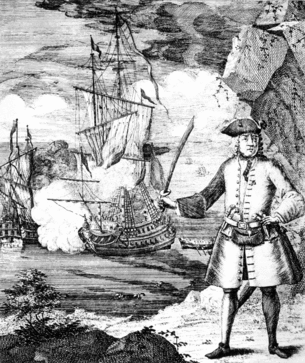Ganj-i-Sawai
The Ganj-i-Sawai (Persian/Hindustani: گنج سواہی, Ganj-i-Sawai, in English "Exceeding Treasure", often anglicized as Gunsway) was an armed Ghanjah dhow (trading ship) belonging to the Mughal emperor Aurangzeb which, along with her escort Fateh Muhammed, was captured on 7 September 1695 by the English pirate Henry Every en route from present day Mocha, Yemen to Surat, India.

Capture by pirates
In August 1695, Henry Every, captaining the 46-gun, 5th rate frigate Fancy, reached the Mandab Strait, where he teamed up with five other pirate ships, including Thomas Tew's 8-gun, 46-man sloop-of-war Amity, Richard Want in the Dolphin, Joseph Faro in Portsmouth Adventure, Thomas Wake in Susannah, and William Maze in the Pearl. Although a Mughal convoy of 25 ships bound for India had eluded the pirate fleet during the night, the following day they encountered the Ganj-i-Sawai and her escort Fateh Muhammed, both stragglers passing the straits en route to Surat.
Every and his men attacked the Fateh Muhammed, which had earlier repulsed an attack by Amity, killing Captain Tew. Perhaps intimidated by Fancy's 46 guns or weakened by their earlier battle with Tew, Fateh Muhammed's crew put up little resistance, and Every's pirates sacked the ship and came away with £40,000 worth of treasure.
Every now sailed in pursuit of the Ganj-i-Sawai, overtaking her about eight days out of Surat. The Ganj-i-Sawai was a fearsome opponent, mounting 62 guns and a musket-armed guard of four to five hundred[1] as well as six hundred other passengers. But the opening volley evened the odds, as one of the Indian ship's cannons exploded, killing some of its gunners and causing great confusion and demoralization among the crew, while Every's broadside shot his enemy's mainmast by the board. The larger Fancy drew alongside, and a number of her 113-man crew clambered aboard, overpowering the crew, passengers and slaves of the Ganj-i-Sawai.
The victorious pirates then subjected their captives to several days of horror, raping and murdering prisoners at will, and using torture to force them to reveal the location of the ships' treasure.[2] The pirates raped women on the ship, and some of the women committed suicide by jumping into the sea.[3][4]
The loot from the Ganj-i-Sawai totalled between £325,000 and £600,000, including "some 500,000 gold and silver pieces, plus numerous jeweled baubles and miscellaneous silver cups, trinkets, and so on."[5] Several crews went home empty-handed: Tew was dead, Want and Wake's ships were too slow and never made it to the battle, Faro made it to the Ganj-i-Sawai but never engaged, and Maze was present but Every took back their share of the loot after the Pearl's crew tried to trade clipped coins to the Fancy's men.[2] Every had been asked by the other pirate captains to carry the treasure to an agreed upon location where it would be split among the various crews, as the Fancy, with her 46 guns, carried the most fire power to guard it. Come nightfall, Every and his crew silently slipped away from the pirate armada, taking all the Ganj-i-Sawai's treasure with them.
In response to the capture of the Ganj-i-Sawai, the Great Mughal, Aurangzeb, sent his army to five key ports for English trade in India, in order to close them: Bombay, Surat, Broach, Agra, and Ahmedabad. Aurangzeb effectively cut off English trade with India, for he would not reopen the ports until Henry Every was caught and executed for his crimes. The East India Company reconciled with the Great Mughal by fully compensating his losses, and filed an insurance claim for £350,000,[6] though Aurangzeb requested this amount be doubled. The desire to see Every executed led to the first truly global manhunt in history, though he and the majority of his crew would never be caught. Six members of his crew were captured, tried, and executed, though they were not found guilty of seizing the Ganj-i-Sawai, but rather a different ship.
In popular culture
The Ganj-i-Sawai Heist and its loot feature prominently in the 2016 video game Uncharted 4: A Thief's End.
See also
- Rahīmī (Mughal ship)
- Aurangzeb
- Child's War
- Dhow
- Baghlah
- Ghanjah
- Hajj
- Mughal Empire
References
- Harris, Graham (2002). Treasure and Intrigue: The Legacy of Captain Kidd. Toronto: Dundurn. p. 88. ISBN 9781550024098. Retrieved 27 June 2017.
- Rennie, Neil (2013). Treasure Neverland: Real and Imaginary Pirates. Oxford: OUP Oxford. ISBN 9780191668654. Retrieved 27 June 2017.
- Doug Lennox (2008). Now You Know Pirates: The Little Book of Answers (illustrated ed.). Dundurn. p. 70. ISBN 978-1-55002-806-5.
- Jadunath Sarkar (1962), A Short History of Aurangzib, 1618–1707.
- Burgess, Douglas R., Jr. (2014). The Politics of Piracy: Crime and Civil Disobedience in Colonial America. Lebanon, NH: ForeEdge. p. 53. ISBN 9781611685275.
- Burgess, Donald, R., Jr. (2009). The Pirates' Pact: The Secret Alliances Between History's Most Notorious Buccaneers and Colonial America. New York: McGraw Hill. pp. 143. ISBN 9780071474764.
- Woodard, Colin (2007). The Republic of Pirates: Being the True and Surprising Story of the Caribbean Pirates and the Man Who Brought Them Down. Orlando, FL: Houghton Mifflin Harcourt. pp. 20–23. ISBN 978-0-15-101302-9.
- Botting, Douglas (1978). The Seafarers: The Pirates. Time-Life Books. pp. 82–83.
